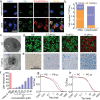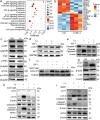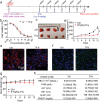A Lipid-Sensitive Spider Peptide Toxin Exhibits Selective Anti-Leukemia Efficacy through Multimodal Mechanisms
- PMID: 38962935
- PMCID: PMC11348133
- DOI: 10.1002/advs.202404937
A Lipid-Sensitive Spider Peptide Toxin Exhibits Selective Anti-Leukemia Efficacy through Multimodal Mechanisms
Abstract
Anti-cancer peptides (ACPs) represent a promising potential for cancer treatment, although their mechanisms need to be further elucidated to improve their application in cancer therapy. Lycosin-I, a linear amphipathic peptide isolated from the venom of Lycosa singorensis, shows significant anticancer potential. Herein, it is found that Lycosin-I, which can self-assemble into a nanosphere structure, has a multimodal mechanism of action involving lipid binding for the selective and effective treatment of leukemia. Mechanistically, Lycosin-I selectively binds to the K562 cell membrane, likely due to its preferential interaction with negatively charged phosphatidylserine, and rapidly triggers membrane lysis, particularly at high concentrations. In addition, Lycosin-I induces apoptosis, cell cycle arrest in the G1 phase and ferroptosis in K562 cells by suppressing the PI3K-AKT-mTOR signaling pathway and activating cell autophagy at low concentrations. Furthermore, intraperitoneal injection of Lycosin-I inhibits tumor growth of K562 cells in a nude mouse xenograft model without causing side effects. Collectively, the multimodal effect of Lycosin-I can provide new insights into the mechanism of ACPs, and Lycosin-I, which is characterized by high potency and specificity, can be a promising lead for the development of anti-leukemia drugs.
Keywords: PI3K‐AKT‐mTOR signaling pathway; anticancer peptide; apoptosis; cell cycle arrest; ferroptosis; leukemia.
© 2024 The Author(s). Advanced Science published by Wiley‐VCH GmbH.
Conflict of interest statement
The authors declare no conflict of interest.
Figures







Similar articles
-
Arginine modification of lycosin-I to improve inhibitory activity against cancer cells.Org Biomol Chem. 2017 Nov 15;15(44):9379-9388. doi: 10.1039/c7ob02233f. Org Biomol Chem. 2017. PMID: 29090725
-
Antimicrobial potential of lycosin-I, a cationic and amphiphilic peptide from the venom of the spider Lycosa singorensis.Curr Mol Med. 2013 Jul;13(6):900-10. doi: 10.2174/15665240113139990045. Curr Mol Med. 2013. PMID: 23638903
-
Position Effect of Fatty Acid Modification on the Cytotoxicity and Antimetastasis Potential of the Cytotoxic Peptide Lycosin-I.J Med Chem. 2019 Dec 26;62(24):11108-11118. doi: 10.1021/acs.jmedchem.9b01126. Epub 2019 Dec 4. J Med Chem. 2019. PMID: 31735030
-
Spider peptide toxin lycosin-I induces apoptosis and inhibits migration of prostate cancer cells.Exp Biol Med (Maywood). 2018 May;243(8):725-735. doi: 10.1177/1535370218772802. Exp Biol Med (Maywood). 2018. PMID: 29763387 Free PMC article.
-
Latarcins: versatile spider venom peptides.Cell Mol Life Sci. 2015 Dec;72(23):4501-22. doi: 10.1007/s00018-015-2016-x. Epub 2015 Aug 19. Cell Mol Life Sci. 2015. PMID: 26286896 Free PMC article. Review.
Cited by
-
Animal Venoms as Potential Antitumor Agents Against Leukemia and Lymphoma.Cancers (Basel). 2025 Jul 14;17(14):2331. doi: 10.3390/cancers17142331. Cancers (Basel). 2025. PMID: 40723215 Free PMC article. Review.
-
Hedgehog and PI3K/Akt/mTOR Signaling Pathways Involvement in Leukemic Malignancies: Crosstalk and Role in Cell Death.Cells. 2025 Feb 13;14(4):269. doi: 10.3390/cells14040269. Cells. 2025. PMID: 39996741 Free PMC article. Review.
-
[The peptide toxin components and nucleotide metabolites in Macrothele raveni venom synergistically inhibit cancer cell proliferation by activating the pro-apoptotic pathways].Nan Fang Yi Ke Da Xue Xue Bao. 2025 Jul 20;45(7):1460-1470. doi: 10.12122/j.issn.1673-4254.2025.07.12. Nan Fang Yi Ke Da Xue Xue Bao. 2025. PMID: 40673308 Free PMC article. Chinese.
References
MeSH terms
Substances
Grants and funding
- 2023GK3009/Subversive Innovation Competition Project of Hunan Province
- 2020RC4023/Science and Technology Innovation Program of Hunan Province
- 2023SK2096/Scientific Research Program of FuRong Laboratory
- 32201044/National Natural Science Foundation of China
- 81100360/National Natural Science Foundation of China
LinkOut - more resources
Full Text Sources
Medical
Miscellaneous
